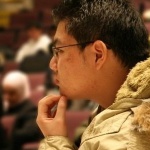July 1, 2010
Toronto becomes a war zone

Photo by Miriam Kim. Monday, 29th of June 2010, located on University Avenue on West Dundas Street. An innocent man who was riding his bicycle was passing through and the officer was gripping his arm and forcing him off the street. The officer was yelling in his ears as the innocent cyclist was smiling and being obedient to the officer's demands.
The G8 and G20 summits that took place in Huntsville and Toronto from Friday, June 25 to Sunday, June 27 were overshadowed by unprecedented arrests before and during the events.
By early Saturday evening parts of downtown Toronto looked like a war zone. By Sunday, around 500 to 600 arrests had been made, with detainees held in a makeshift detention facility at 629 Eastern Ave.
How could this all happen when the protests organized by large civil society groups like the Canadian Labour Congress, the Defenders of the Land, the Ontario Coalition Against Poverty (OCAP), and the Toronto Community Mobilization Network remained largely peaceful?
Thursday June 24
The indigenous rights rally, although heavily monitored, went off almost without a hitch.
However, it was also on this day that most people found out that the provincial legislature had passed the Public Works Act in secret on June 2, thereby allowing anyone within five metres of the G20 security fence to be searched and questioned.
Dave Vasey, who refused to show his ID and who claims to have had no idea of the legislation, was arrested.
Friday June 25
The anti-poverty rally organized by OCAP saw a few confrontations, but the protests were largely peaceful.
However, Emomotimi Azorbo, who is deaf and did not hear the police’s call to clear the street, was beaten and arrested. This incident was perhaps the first sign that the conduct of policing bodies on the weekend would raise alarms.
Saturday June 26
The largest protest of the week, organized by Big Labour, saw around 25,000 people from dozens of civil society groups march in downtown Toronto.
Remarkably, this colossal demonstration went peacefully.
However, occurring simultaneously with this huge demonstration were acts of vandalism by a small number of people, who tore through Yonge Street, Queen Street, and other parts of the downtown core, smashing shop and bank windows. (There were no reports of injuries, as these acts were mostly symbolic.)
The identities of these “protesters” are largely unknown, although most of the corporate media has clumsily labelled the “The Black Bloc,” a supposed anarchist body.
What transpired later will stain the memory of this city—riot police used tear gas for the first time in the city’s history.
In fact, it was clear that at one point, the police simply stopped distinguishing between peaceful protesters, rioters, and bystanders.
As the violence took on a life of its own, two police cruisers were smashed and almost flipped over on the intersection of Queen and Spadina streets. Who did it? No one knows.
A number of police cars were also set on fire. Curiously, all these cruisers had been left unattended! (so much for a $1 billion security).
Numerous streets were also blocked off by riot police, who moved to different sections of the city without warning. The Queen’s Park area (University Street and College Street) was occupied by around 20,000 police officers. One university student was almost trampled by police on horseback.
Sunday June 27
The last day saw more of the same, as peaceful protesters were dispersed violently with tear gas and batons as they gathered around the detention facility and called for the release of over 500 detainees.
On the same day, at least 70 people were arrested from the University of Toronto Graduate School Union, with the police claiming that they were illegally housed “anarchists,” mostly from Montreal.
Furthermore, the G20 convergence area on Queen Street West was raided, with around 30 arrests being made. The day eventually ended with a stand-off at Queen and Spadina where peaceful protestors were again arrested and dispersed.
Though the summits are over, this unprecedented weekend left large question marks on the state of Canadian democracy.
Steven Zhou is an undergraduate student at the University of Toronto.








